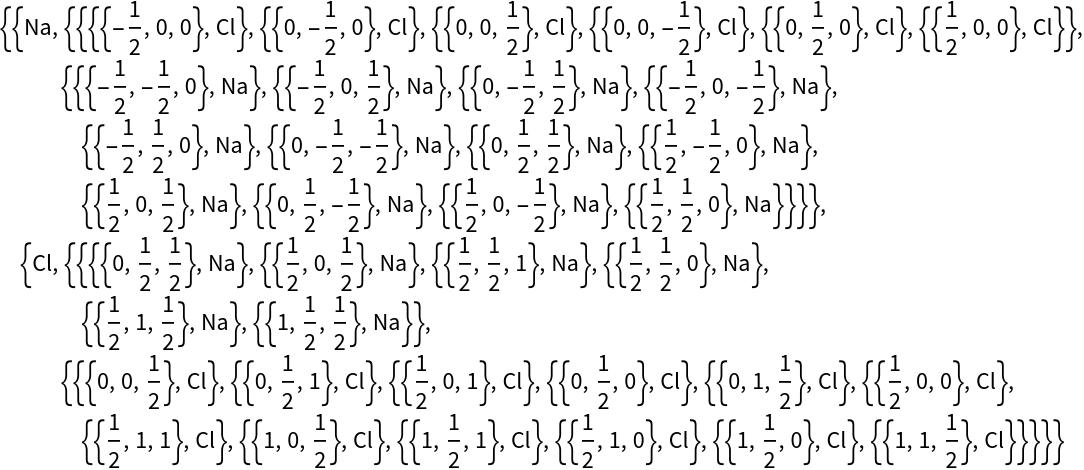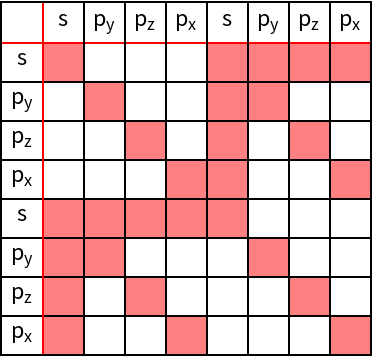- Tutorials
-
See Also
- GTBands
- GTBandStructure
- GTCluster
- GTDensityOfStates
- GTPartialDOS
- GTHamiltonianList
- GTHamiltonianPlot
- GTReadFromFile
- GTShells
- GTTbHamiltonianElement
- GTTbHamiltonianRS
- GTTbMatrixElement
- GTTbParmToRule
- GTTbSpinOrbit
- GTTbSymbol2C
- GTTbToFortran
- GTVibDynamicalMatrix
- GTVibSetParameters
- GTVibTbToPhonon
- GTVibTbToPhononRule
- GTWriteToFile
- GTTbHamiltonianOnsite
- GTReorderMatrix
- GTTbWannier90Hamiltonian
- Related Guides
GTTbHamiltonian
GTTbHamiltonian[basis,lattice]
constructs the k-dependent Hamiltonian from the information about basis and lattice.
DetailsDetails
- The command constructs tight-binding Hamiltonians in the two-center form from the information about the atoms in the basis and the lattice. The Hamiltonian will be set up in a general form containing an appropriate notation of the hopping parameters and the general dependence on the wave vector k.
- The informaton about the basis contains the names of the corresponding elements and the angular momenta. The angular momenta are represented by a list. Therefore it is possible to adapt the Hamiltonian to a specific problem.
- It is possible to construct Hamiltonians for multiple atoms in the unit cell. If only one atom in the unit cell is present, the element name in the information about the basis is not used to construct the parameter names.
- If the structure is simple, the lattice information can be constructed by hand. Otherwise GTGetStructure allows to retrieve a structure from the spacegroup database. The lattice information can be constructed from the space group information, GTCluster and GTShells.
- The lattice information is construted as follows:
- lattice = {{interaction, number of shells, list of the positions in the shells},
{interaction, number of shells, list of the positions in the shells}, ... } - If only one atom is present, interaction=0 is used, otherwise interaction has to define the interaction between the different atoms in the basis. If we have two atoms "A", "B" in the basis, we have to define the interactions: "A,A", "B,B", "A,B"
- See: J. C. Slater, G. F. Koster,Simplified LCAO method for the periodic potential problem, Phys. Ref. 94, 1498-1524 (1954)
- W. Hergert, M. Geilhufe, Group Theory in Solid State Physics and Photonics. Problem Solving with Mathematica, chapter 9.4.1
ExamplesExamplesopen allclose all
Basic Examples (1)Basic Examples (1)
| In[1]:= |
If we want to construct the Hamiltonian for an fcc transition metal like Cu we will set the basis information as:
| In[2]:= |
For the fcc-structure the lattice information can be set up by hand:
| In[3]:= |
| In[4]:= |
| In[5]:= |
A better presentation of the matrixelements is given by means of GTHamiltonianList
The NaCl structure contains two basis atoms. The information about the structure can be found in the space group database.
| In[1]:= |
We construct a spherical cluster using this information:
The lattice constant is set to a = 1. Now the cluster is reordered in shells. Four shells around each basis atom are considered.
It can be seen that the Na atoms are surrounded by Cl atoms, and vice versa. We take into account only the Na-Cl interactions.
Because we want to study PbTe, we have to substitute the names of the atoms.
The information about the basis is, because only s and p electrons are considered:
See AlsoSee Also
GTBands ![]() GTBandStructure
GTBandStructure ![]() GTCluster
GTCluster ![]() GTDensityOfStates
GTDensityOfStates ![]() GTPartialDOS
GTPartialDOS ![]() GTHamiltonianList
GTHamiltonianList ![]() GTHamiltonianPlot
GTHamiltonianPlot ![]() GTReadFromFile
GTReadFromFile ![]() GTShells
GTShells ![]() GTTbHamiltonianElement
GTTbHamiltonianElement ![]() GTTbHamiltonianRS
GTTbHamiltonianRS ![]() GTTbMatrixElement
GTTbMatrixElement ![]() GTTbParmToRule
GTTbParmToRule ![]() GTTbSpinOrbit
GTTbSpinOrbit ![]() GTTbSymbol2C
GTTbSymbol2C ![]() GTTbToFortran
GTTbToFortran ![]() GTVibDynamicalMatrix
GTVibDynamicalMatrix ![]() GTVibSetParameters
GTVibSetParameters ![]() GTVibTbToPhonon
GTVibTbToPhonon ![]() GTVibTbToPhononRule
GTVibTbToPhononRule ![]() GTWriteToFile
GTWriteToFile ![]() GTTbHamiltonianOnsite
GTTbHamiltonianOnsite ![]() GTReorderMatrix
GTReorderMatrix ![]() GTTbWannier90Hamiltonian
GTTbWannier90Hamiltonian











